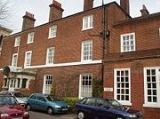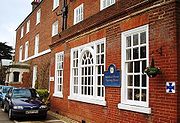
Diocesan House, St Albans
Encyclopedia

St Albans
St Albans is a city in southern Hertfordshire, England, around north of central London, which forms the main urban area of the City and District of St Albans. It is a historic market town, and is now a sought-after dormitory town within the London commuter belt...
on the northern side between Church Crescent and Britton Avenue opposite College Street .
It is now known as Verulam House and has also been referred to as the Bishop's Palace.

General Lying-In Hospital
The General Lying-In Hospital was opened in April, 1767, as the Westminster New Lying-in Hospital, on the north side of Westminster Bridge Road Lambeth with Dr. John Leake as its first physician....
which had been evacuated from York Road, Lambeth
York Road, Lambeth
York Road is a road in Lambeth, London running between Westminster Bridge Road and Waterloo Road . To the west is the old County Hall, Shell Centre, Jubilee Gardens and, beyond, the London Eye and the River Thames. Waterloo Station is located on the road's eastern edge, as well as the former...
, (Waterloo), in central London.
During the period between September 1939 and June 1946 two thousand babies were born here.
The General Lying-In Hospital was re-established at its former Lambeth
Lambeth
Lambeth is a district of south London, England, and part of the London Borough of Lambeth. It is situated southeast of Charing Cross.-Toponymy:...
premises in 1946 after the end of the war.
The Registrar of Births, Deaths and Marriages of Hertfordshire in the district of St Albans at that time indicated that the place of birth was Diocesan House, Verulam Road, St Albans Urban District.

Verulam House, St Albans
Verulam House is located in Verulam Road, St Albans AL3 4DH on the northwestern side between Church Crescent and Britton Avenue opposite College Street.It has previously been referred to as Diocesan House and also known as the Bishop's Palace....
as it was by then again known, which had since 1926 been used mainly as a Diocesan Retreat and Conference Centre by the Church of England
Church of England
The Church of England is the officially established Christian church in England and the Mother Church of the worldwide Anglican Communion. The church considers itself within the tradition of Western Christianity and dates its formal establishment principally to the mission to England by St...
Diocese of St Albans, was sold and a trust fund set up with the proceeds.
Since 1996 the House has been the site of the 'Verulam House Nursing and Residential Home'.


